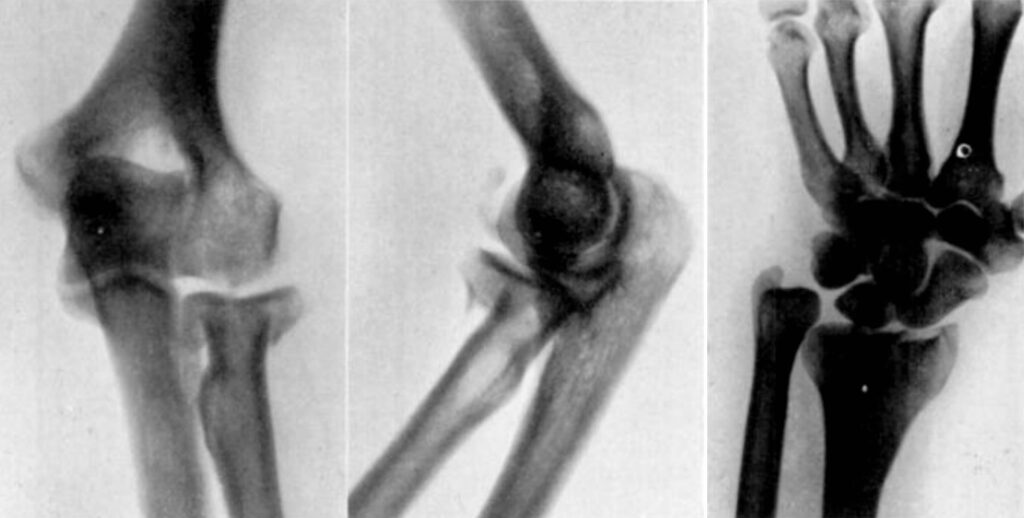Peter Essex-Lopresti

Peter Gordon Lawrence Essex-Lopresti (1916-1951) was a British orthopaedic surgeon.
Notable work for Essex-Lopresti includes his classification and treatment of fractures of the calcaneus and his recommendations for paratroopers to avoid injury. Eponymously affiliated with the Essex-Lopresti fracture (1951) published a month before his sudden death.
Gifted pianist, highly promising career cut short aged 35 following an acute myocardial infarction.
Biography
- Born on April 7, 1916
- 1937 – Qualified medicine, the London Hospital (now Royal London)
- 1938 – Qualified DA, anaesthetic training
- 1940 – Commenced training in orthopedic surgery
- 1942 – Fellowship of the Royal College of Surgeons of Edinburgh
- 1943 – Surgical specialist in the Royal Army Medical Corps (RAMC) airborne division
- 1947 – Consultant Orthopaedic surgeon, Birmingham Accident Hospital
- 1951 – Hunterian Professorship. Hunterian Lecture (March 6, 1951) ‘The Mechanism, Reduction Technique, and Results in Fractures of Os Calcis.’
- Died on June 13, 1951 at home (aged 35), myocardial infarction
Medical Eponyms
Essex-Lopresti fracture (1951)
An Essex-Lopresti injury involves the triad of a radial head fracture with dislocation of the distal radioulnar joint (DRUJ) and disruption of the interosseous membrane (IOM)
In 1951, Essex-Lopresti reported two cases. He noted that:
- this was a rare injury but suggested that DRUJ integrity must be inspected when a radial head fracture is present;
- that radial head fracture and DRUJ dislocation were associated with IOM disruption;
- excision of the radial head should be avoided and ORIF should be employed
- in cases with severe comminution, a prosthesis could be used to replace the radial head

Key Medical Attributions
1946 – ‘The Hazards of Parachuting‘ chronicled the parachute-related injuries with 20,777 parachute jumps made by men in the Sixth British Airborne Division. Essex-Lopresti defined three phases of the jump: Exit plane; Open chute and Landing. He provided recommendations paratroopers could employ to avoid injury included: extending the neck to avoid hitting the forehead trauma on exiting the plane and keeping legs together when landing to prevent ankle injuries
Major Publications
- Essex-Lopresti P. Fractures of the radial head with distal radio-ulnar dislocation; report of two cases. J Bone Joint Surg Br. 1951 May;33B(2):244-7
- Essex-Lopresti P. The hazards of parachuting. Br J Surg. 1946 Jul;34:1-13.
- Essex-Lopresti P. The problems of airborne surgery. Lond Hosp Gaz 1948; 51:7-13
- Essex-Lopresti P. The mechanism, reduction technique, and results in fractures of the os calcis. Br J Surg. 1952 Mar;39(157):395-419
- Essex-Lopresti P. The open wound in trauma. Lancet. 1950 Apr 22;1(6608):745-51.
References
Biography
- In Memoriam: Peter Gordon Lawrence Essex-Lopresti F.R.C.S.E., D.A. Lancet. 1951;257(6669):1372.
- In Memoriam: Peter Gordon Essex-Lopresti (1916-1951). J Bone Joint Surg. 33B(3):453
- Mostofi SB. Who’s Who in Orthopedics. Springer 2005: 99-100
Eponymous terms
- McGlinn EP, Sebastin SJ, Chung KS. A Historical Perspective on the Essex-Lopresti Injury. J Hand Surg Am. 2013 Aug; 38(8): 1599–1606.
MBChB (University of Bristol), BSc (Durham University). Emergency medicine RMO at Sir Charles Gairdner hospital. Swimmer, interested in all things sports medicine.

